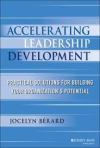Contributed by Global Knowledge
Today’s business recruiters face a growing concern over the future of leadership. This concern is certainly not unfounded – by the year 2020 over a quarter of the workforce will be aged 55 and over (compared to just 13% in 2000), and many of these will hold senior positions in their organization. Employers are therefore being faced with the sensitive task of bridging the skills gap in a bid to find new leaders to replace those who are heading towards retirement.
 Jocelyn Bérard, Global Knowledge’s Vice President is one leader who is working diligently to steer organizations through the leadership predicament towards a green light solution. In his latest publication Accelerating Leadership Development: Practical Solutions for Building Your Organization’s Potential, Bérard identifies key ways in which employers can work to fill leadership roles, whether through leadership training or business development strategies.
Jocelyn Bérard, Global Knowledge’s Vice President is one leader who is working diligently to steer organizations through the leadership predicament towards a green light solution. In his latest publication Accelerating Leadership Development: Practical Solutions for Building Your Organization’s Potential, Bérard identifies key ways in which employers can work to fill leadership roles, whether through leadership training or business development strategies.
According to Bérard, the book’s main purpose is to aid businesses to “speed up the process of leadership development [by making sure that they] have the right opportunities and infrastructure to retain that talent.” The publication includes a step-by-step approach to accelerating leadership development within the workplace, which seeks to lay the foundations for organizations to “identify talent gaps, select next-generation talent, determine leadership requirements and give them [employees] the tools they need to succeed.”
The publication also includes interviews with top international academics and executives from Europe and North America who offer sound advice on how to find, encourage and nurture emerging talent in the workplace.
In addition to his recent book, Bérard also regularly offers leadership advice in industry publications both online and in print. In a recent article on accelerating leadership development, Bérard identified two key strategies for organizations seeking to prepare for leadership succession:
1. The 9-Box Grid
A core part of the solution is identifying potential leader candidates, this may be an employee who consistently produces work of a high standard and is skilled in every area of their role. One tool, which Bérard suggests organizations can use, is the nine-box grid that can be used to position potential leaders on a low, medium and high performance scale.
However, merely scoring employees with a performance rating is not enough to predict and rate potential leaders. Bérard identifies six factors that employees need to take into account in order to assess future leaders. These are:
- Cognitive complexity and capacity
- Learning orientation: self and others
- Drive and achievement orientation
- Motivation to lead
- Social and emotional complexity and capacity
- Personal and business ethics
These factors are believed to be essential in order to streamline the leadership assessment process.
2. Carefully Identify Potential Leaders Through Diagnosis
Meticulously assessing a potential leader’s capabilities, competencies, experience and knowledge is essential in order to recognize strengths and identify room for improvement. Bérard says options for assessment could include “360-degree surveys or simulations, validated personality traits inventories, tailored knowledge, and an experience review interview or questionnaire.”
Using these four components to appropriately assess potential-leaders will give employers an accurate indication of whether a candidate is ready to make the leap of faith towards leadership training and development.
Author Note: Global Knowledge are IT and business training providers who organize a number of leadership development training events designed to offer practical solutions for building an organization’s potential. The next event will be hosted by Jocelyn Bérard on the 2nd December. Visit the website to find out more.
—
The Product Management Perspective: Many product management leaders face challenges with aging individual contributors on their teams. What makes this challenge even more difficult is the shortage of college programs focused on product management, which means new candidates need training and preparation beyond what they get in college to get started. Therefore, product management leaders must focus on not only finding people with the right skills to lead their products, but also on training them for their job. When hiring a VP or Director of Product Management, make sure your chosen candidate understands these aspects and will focus on developing leaders in your product organization.